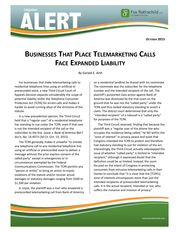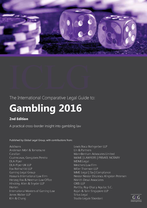Lease Termination Before Bankruptcy May Be ‘Avoidable Transfer,’ 7th Circuit Rules – March 16, 2016
Fox Rothschild
Description
Financial Restructuring & Bankruptcy Alert | March 2016
. . if . .
. such lease is of nonresidential real property and has been terminated under applicable non-bankruptcy law prior to the order for relief.” 11 U.S.C. § 365(c)(3). The Circuit Court remarked that the Bankruptcy Court’s reliance on section 365(c)(3) put it “on a collision course” with section 101(54)(D), which “covers not only property but also an interest in property, and a lease is an interest in property.” “Section 365(c) is aimed at facilitating the re-leasing of commercial property during bankruptcy proceedings by forbidding the trustee to interfere with the occupancy of the new tenants.” It prohibits the trustee from assuming and assigning the leases to a different tenant.
But the committee isn’t seeking the leases themselves, rather to avoid them (under Bankruptcy Code sections 547 & 548) and to recover their value (under Bankruptcy Code section 550). “Section 365(c)(3) is therefore inapplicable.” After terminating the leases with the debtor, the landlord leased the two stores to a different oil change company. “If the bankruptcy court were to order the stores turned over to Great Lakes’ creditors, this would have the disruptive effect on commercial activity against which section 365(c)(3) is aimed.
But to repeat, the creditors are seeking not the leases but the value of the leases that Great Lakes transferred to T.D. They are not trying to evict anyone.” The Seventh Circuit concluded by reiterating that the “distinction between the value of the leases (value to which the creditors may be entitled) and the leases themselves (which cannot lawfully be transferred to them) enables the purpose of section 365(c)(3) to be fulfilled without making inroads into section 101(54)(D). The bankruptcy judge’s reading of 365(c)(3) placed the two sections in needless conflict.” Notably, the Circuit Court did not discuss the significant body of case law (cited in the Bankruptcy Court decision (528 B.R. 893)) holding that the prepetition termination of a lease is not an avoidable transfer.
Neither did the Court mention section 8(e)(1) of the Uniform Fraudulent Transfer Act, specifically stating that a transfer is not voidable if it results from the “termination of a lease upon default by the debtor when the termination is pursuant to the lease and applicable law.” For more information on this alert, please contact Audrey Noll at 310.693.4414 or anoll@foxrothschild.com or any member of the firm’s Financial Restructuring & Bankruptcy Department. Attorney Advertisement © 2016 Fox Rothschild LLP. All rights reserved. All content of this publication is the property and copyright of Fox Rothschild LLP and may not be reproduced in any format without prior express permission.
Contact marketing@foxrothschild.comfor more information or to seek permission to reproduce content. This publication is intended for general information purposes only. It does not constitute legal advice. The reader should consult with knowledgeable legal counsel to determine how applicable laws apply to specific facts and situations.
This publication is based on the most current information at the time it was written. Since it is possible that the laws or other circumstances may have changed since publication, please call us to discuss any action you may be considering as a result of reading this publication. www.foxrothschild.com .
. such lease is of nonresidential real property and has been terminated under applicable non-bankruptcy law prior to the order for relief.” 11 U.S.C. § 365(c)(3). The Circuit Court remarked that the Bankruptcy Court’s reliance on section 365(c)(3) put it “on a collision course” with section 101(54)(D), which “covers not only property but also an interest in property, and a lease is an interest in property.” “Section 365(c) is aimed at facilitating the re-leasing of commercial property during bankruptcy proceedings by forbidding the trustee to interfere with the occupancy of the new tenants.” It prohibits the trustee from assuming and assigning the leases to a different tenant.
But the committee isn’t seeking the leases themselves, rather to avoid them (under Bankruptcy Code sections 547 & 548) and to recover their value (under Bankruptcy Code section 550). “Section 365(c)(3) is therefore inapplicable.” After terminating the leases with the debtor, the landlord leased the two stores to a different oil change company. “If the bankruptcy court were to order the stores turned over to Great Lakes’ creditors, this would have the disruptive effect on commercial activity against which section 365(c)(3) is aimed.
But to repeat, the creditors are seeking not the leases but the value of the leases that Great Lakes transferred to T.D. They are not trying to evict anyone.” The Seventh Circuit concluded by reiterating that the “distinction between the value of the leases (value to which the creditors may be entitled) and the leases themselves (which cannot lawfully be transferred to them) enables the purpose of section 365(c)(3) to be fulfilled without making inroads into section 101(54)(D). The bankruptcy judge’s reading of 365(c)(3) placed the two sections in needless conflict.” Notably, the Circuit Court did not discuss the significant body of case law (cited in the Bankruptcy Court decision (528 B.R. 893)) holding that the prepetition termination of a lease is not an avoidable transfer.
Neither did the Court mention section 8(e)(1) of the Uniform Fraudulent Transfer Act, specifically stating that a transfer is not voidable if it results from the “termination of a lease upon default by the debtor when the termination is pursuant to the lease and applicable law.” For more information on this alert, please contact Audrey Noll at 310.693.4414 or anoll@foxrothschild.com or any member of the firm’s Financial Restructuring & Bankruptcy Department. Attorney Advertisement © 2016 Fox Rothschild LLP. All rights reserved. All content of this publication is the property and copyright of Fox Rothschild LLP and may not be reproduced in any format without prior express permission.
Contact marketing@foxrothschild.comfor more information or to seek permission to reproduce content. This publication is intended for general information purposes only. It does not constitute legal advice. The reader should consult with knowledgeable legal counsel to determine how applicable laws apply to specific facts and situations.
This publication is based on the most current information at the time it was written. Since it is possible that the laws or other circumstances may have changed since publication, please call us to discuss any action you may be considering as a result of reading this publication. www.foxrothschild.com .













